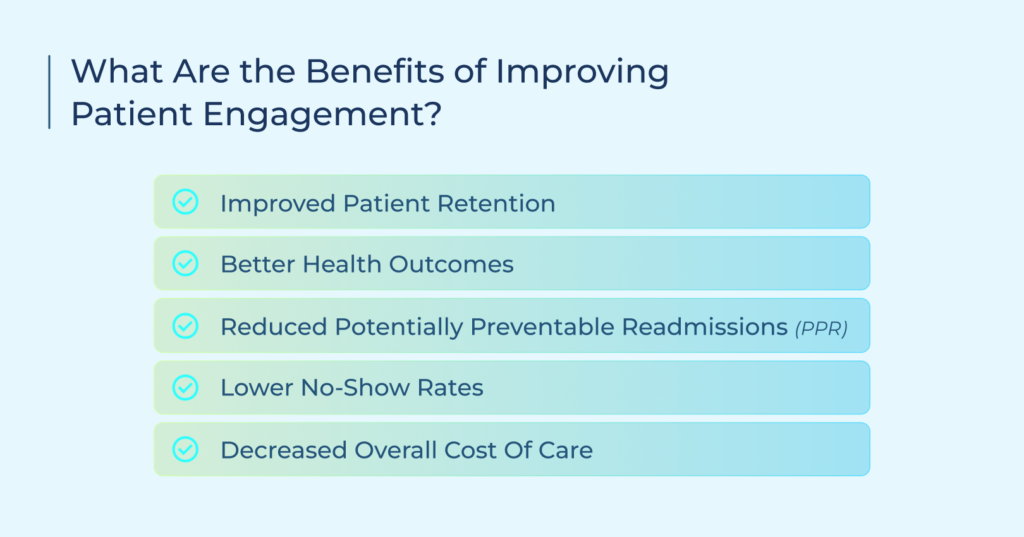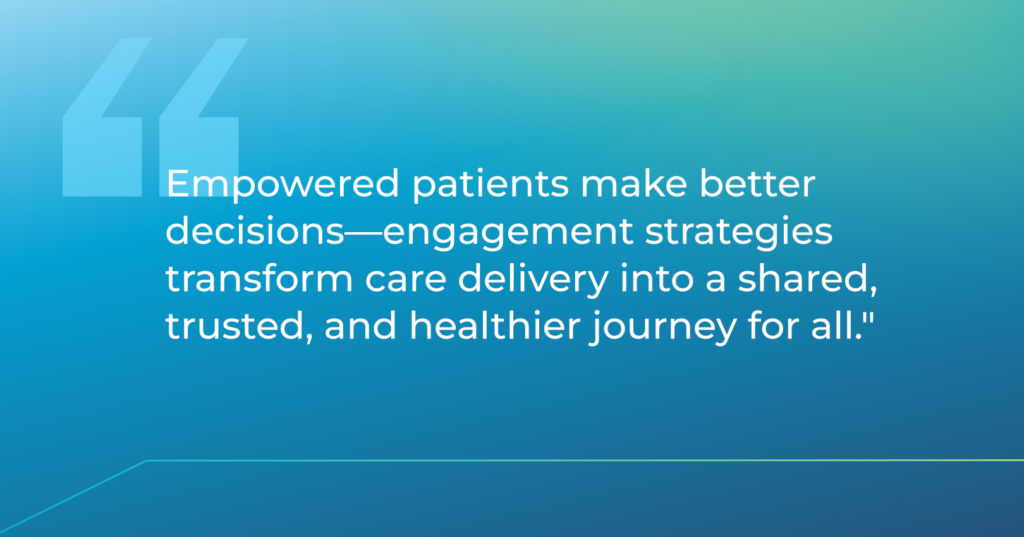Your patients' feedback goes far beyond collecting just opinions and sentiments. It's hard data that…

Patient Engagement Strategies for Better Healthcare Outcomes
Effective patient engagement strategies form the cornerstone for achieving better health outcomes and increased patient satisfaction. Modern healthcare organizations understand that successful treatment plans begin with giving patients a voice in their healthcare journey. Patients want to have a say in their treatment plans. They want their conditions to be understood. They won’t place their trust in any medical advice unless otherwise.
This blog explores the importance of patient engagement, what benefits providers get, common pitfalls, and more to drive patient satisfaction and loyalty.
Why Is Patient Engagement Important?
Successful healthcare providers focus on educating and convincing patients to actively participate in their care instead of waiting for them to reach out for care on their own. The former indicates quality care, while the latter leads to poor health outcomes.
Exceptional patient engagement is essential in that regard. When patients are satisfied with their healthcare experiences, they readily follow their medical advice. On the other hand, patients with bad experiences in the past are prone to failing to adhere to necessary care.
Engaged patients are also likely to manage chronic conditions more effectively and make informed decisions about their health for the long term. This active participation is beneficial for both patients and providers, leading to healthier lives, reduced hospital readmissions, lower healthcare costs, and improved overall health outcomes.
12 Strategies to Improve Patient Engagement in Healthcare
Below are some practical approaches healthcare organizations can implement to improve their overall patient engagement.
1. Use Technology to Improve Patient Engagement
Digital solutions like patient portals are the need of the day. They not only reduce administrative burden but also give patients direct access to their health records, test results, and other information. It’s quick. It’s efficient. It also fulfills a basic requirement of patients wanting to find information on their own without making unnecessary phone calls.
Healthcare providers can also deploy AI-driven virtual agents or chatbots to answer common questions, schedule or reschedule appointments, inquire about on-call doctors and services, etc.
Not to forget telehealth options to make care possible for patients with mobility issues or those in remote areas.
2. The Power of Personalized Patient Communication
Never underestimate the impact of personalized messages. Leverage the patient’s history and health conditions to tailor your communications. This helps build trust and makes the patient feel understood.
Reach out using their preferred channels. Patients who have a history of only taking clinical calls on a specific day or time will appreciate you following suit.
Also, care does not end after the patient leaves. Send follow-up information related to their conditions, health tips, reminders, etc, to further improve patient engagement.
3. Self-Service Scheduling & Health Monitoring
While already covered in the use of technology, online scheduling tools play a major role in improving patient satisfaction. Someone who is stressed or in pain cannot be expected to be rational about long call-waiting times or repeated calls to get an appointment.
Hence, give them the tools to set appointments on their own terms. This also means reduced phone calls for care providers, allowing them to focus their energy and time on something else.
Additionally, remote monitoring is an excellent complement to self-service healthcare options. There are several devices that track vital signs at home, highlighting possible symptoms that enable patients to take active roles in their own care.
4. Deliver Seamless Omnichannel Patient Support
Cover all possible communication channels and ensure you are delivering consistent messaging across all of them. Patients should be free to reach out through their preferred channels (calls, text, SMS, social media, in-app, etc).
They should also receive the same experience and information, ensuring they do not have to repeat themselves after switching channels.
5. Drive Patient Participation With Rewards & Loyalty Programs
Something else that improves patient engagement in healthcare is rewards programs. These encourage patients to be more active in self-care. You can motivate them by simply keeping a points system for keeping appointments. You can also throw down wellness challenges with small prizes to promote healthy habits.
When patients are acknowledged for their efforts such as by reaching certain health milestones, they readibly engage with their care providers in the future.
6. Engage Patients Through Educational Content & Health Insights
Consulting with a medical professional should not be the only way to provide healthcare. Keep your patients educated by sending them newsletters with seasonal health optics. For instance, if pollen’s around the corner, tell them how to take precautions.
Touch complex health conditions with videos and webinars to enable patients to catch early signs. Presenting health data with infographics is also a great way to engage patients without overwhelming them with content brimming with complicated terminologies.
7. Strengthen Patient Connections via Social Media
Social media platforms give patients direct access to healthcare information. Most may also prefer community support groups over pamphlets and handouts at the end of a clinical visit. Healthcare organizations can use that to share educational content, address common health concerns, and provide real-time updates.
Remembering the stressful COVID-19 pandemic times? Verified medical social media channels played a critical role in spreading awareness and precautionary steps.
8. The Role of Mobile Health Apps in Patient Engagement
There’s a reason why major healthcare organizations are always improving their mobile health apps. These can support important features to support patient engagement.
For instance, patients can log into their profiles to check past clinical visits, get medication reminders, track their symptoms, etc.
Mobile apps can also extend your communications by allowing patients to directly message or talk with chatbots for quick information.
9. Maintain Ongoing Patient Communication & Touchpoints
Another strong patient engagement strategy is a continuous outreach throughout the patient journey. It helps keep them engaged and informed. Follow up after surgical procedures to show care. Do regular check-ins for the elderly. While basic, birthday greetings go a long way in creating personal connections.
10. Gather Actionable Insights Through Patient Surveys
The best way to improve your engagement strategies is by asking the patients themselves. Conduct regular surveys to collect feedback at all touchpoints. This includes post-visit questionnaires, comment cards in waiting areas, post-surgery reach-outs, etc.
Keep the questions short and clear to get an insight into how well patients are satisfied with your current operations. Remember that actionable improvements rely on data, which you get from your own patients.
11. Reduce Missed Appointments With Automated Follow-Ups & Reminders
Reducing no-shows also affects your patient engagement levels. Push constant reminders to give patients plenty of time to reschedule. Keep your communication channels open and clear to keep patients updated with accurate information. Multiple reminder methods catch patients across preferred channels.
You can even consider partnering with local ride-hailing services to help patients in far-flung areas with transportation issues.
12. Use Health News & Trends to Drive Patient Engagement
Seasonal health updates prepare patients for common conditions. Local health event announcements connect patients to community resources. New research summaries related to common conditions keep information current.
What Are the Benefits of Improving Patient Engagement?
Improved patient engagement positively impacts both healthcare providers and patient outcomes, leading to an efficient sector and a healthier community.

- Improved Patient Retention: Effective engagement results in satisfied patients who stick with their healthcare providers. You will never consider changing doctors unless there’s a bad experience or negative referral. Reducing patient churn also leads to improved revenues and growth for healthcare organizations.
- Better Health Outcomes: When patients play an active role in their care plans, they recover faster. Satisfied patients tend to closely follow their treatment plans and will reach out for care on their own.
- Reduced Potentially Preventable Readmissions (PPR): Educating patients about their health conditions makes it less likely that they are going to be readmitted. This is because they understand their medical instructions. Hence, at the earliest warning signs, they tend to contact care providers. This ensures that small issues do not become medical emergencies.
- Lower No-Show Rates: Skipping appointments without informing causes the national healthcare industry millions in losses annually. Care providers can cut that down by simply engaging patients to prioritize their appointments. Through best practices like automated reminders, personalized follow-ups, and flexible rescheduling options, healthcare providers can encourage patients to stay committed to their appointments
- Decreased Overall Cost of Care: Engaged patients seek preventive care and address issues earlier, which costs patients (and care providers) less than a serious health emergency.
Patient Engagement Challenges and How to Address Them
Patients can often face challenges in obtaining and understanding even basic health information. Here are some of the most common pitfalls to patient engagement strategies and how to address them:
1. Communication and Language Barriers
Patients cannot be expected to understand medical terminologies. Their poor health literacy makes it difficult for them to follow treatment plans and understand diagnoses and prognoses. This also includes language barriers and not just education levels. If a patient is fluent in another language and the provider in another, important information will only get lost during communications.
How to Address the Challenge:
Train your staff on clear communication methods. Avoid using medical jargon, but if necessary, explain it plainly for the patient’s understanding.
Reports should also be appropriate for all reading levels. Use numbers and visual aids to represent important information instead of paragraphs of complex terms.
Additionally, provide multilingual materials and hire interpreters based on the languages commonly spoken in your area to support better patient engagement.
2. Obtaining Patient Trust
How many times have you heard a horror medical story from a friend or contact? These secondhand experiences, as well as personal negative experiences in the past, can make patients hesitant to reach out for care, and even if they do, they will often find it hard to trust their provider’s medical advice.
How to Address the Challenge:
In healthcare, active listening functions as an extraordinary weapon. Patients experience a sense of value and understanding when medical professionals address their concerns with authentic care and empathy. This also gives them a voice in their treatment plans. These patients are most likely to prioritize self-care on their own.
Another way to establish trust between patients and providers is through clear billing practices. Patients often enjoy satisfactory visits but face frustration upon receiving bills filled with unexpected charges. They may feel misled. So, make sure payment plans, insurance coverages, and breakdowns are conveyed with clarity.
3. Technology Adoption Barriers
Self-service digital portals and tools are important for streamlining care, but not at the expense of isolating patients who are not comfortable with technology. A blanket tech approach in healthcare can mean missed appointments, confusion about treatment plans, and just make it harder to engage patients.
How to Address the Challenge:
Give patients who are uncomfortable with technology an alternative way to communicate. Have friendly support agents standing by to answer patient questions and offer guidance.
Improve your online portals with user-friendly interfaces, step-by-step guides, and images to make navigation easier. Reach out to educate patients on how your digital systems work and the benefits they offer. For instance, patients may consider using an online scheduler if they are explained how it’s more convenient.
How to Measure the Impact of Patient Engagement Strategies
Now that you have a clear understanding of how to improve patient engagement, here are some common ways (and metrics) to check whether your healthcare strategies are working:
1. Patient Activation Measure (PAM)
PAM measures how well patients manage their own health and healthcare. These “activated patients” are more proactive in their health management, helping providers identify and focus their messaging on patients who need additional support.
PAM is calculated through questionnaires. Patients are categorized into different activation levels based on their responses.
2. Appointment Booking Rate
It is always helpful to check how many patients successfully booked appointments compared to patients who tried but couldn’t. High booking rates mean an easy and efficient booking system, leading to increased healthcare reach.
Metric Formula: (Total Book Appointments / Total Booking Attempts) x 100
3. Readmission Rate
It measures the percentage of patients who return for care within a specific period after discharge. This is normally set at 30 days. The readmission rate reflects care quality and how effective your communication was in educating the patient about their treatment plans.
Metric Formula: (Total Readmissions / Total Discharges) x 100
4. Patient Retention Rate
Probably the most important patient engagement metric of them all, it refers to the percentage of patients who continue to use healthcare services over a specific period. High retention rates indicate high patient satisfaction levels. It enables providers to understand patient loyalty.
Metric Formula: [(Total New Patients – Total Patients) / Total Patients in the Beginning of the Period)] x 100
5. Patient Satisfaction Scores
As evident, this metric relays how satisfied patients are with their healthcare experiences. This includes everything from staff interaction and cleanliness to care quality and comfort. Your patient satisfaction surveys are an excellent way to get direct feedback for actionable improvements.
Metric Formula: (Total Satisfied Patients / Total Survey Respondents) x 100
Use TeleVox to Improve Patient Engagement in Healthcare
TeleVox has a history of helping major healthcare providers connect with their patients through AI-driven solutions. We bring you the next generation of healthcare with automated appointment reminders, personalized messaging, self-service options, efficient knowledge bases, and more.
Keeping your patients informed and involved in their care has never been easier. Our SMART Agent combines advanced machine learning and conversational AI technologies to engage patients and answer their inquiries without any human intervention. This reduces administrative workload while ensuring patients get the quick support they need 24/7.

With TeleVox, providers can manage all patient communication from a single system, keeping outreach efficient and organized. Schedule a demo today to see how TeleVox can drive your patient engagement at every touchpoint.



